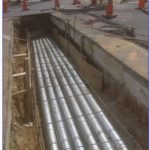- Company: Anchor Construction Corporation
- Industry: Telecom
- Location: Washington, District of Columbia
- Expected Completion Date: June 29, 2016
- Project Website
Installation of concrete encased ductbank, (approximately 900 L.F. of 12-way 4” Sch 40, PVC Conduit) and approx. 500 L.F. of 12-way 5” HDPE, Directional Drilled Conduit under the U.S. Botanical Garden’s Bartholdi Park. Five (5) 6’x12’ precast concrete manholes were also installed. The project also includes permanent roadway patch, milling and overlay of the surrounding streets. Project involved the cooperation of several entities including DDOT, U.S. Botanical Gardens, the Architect of the Capitol, National Park Service, GSA, and Capitol Police.
What impact does this project have on America?
This project was a vital project for the U.S. Government because it provided a direct telecommunications link between the Rayburn House Office Building and the Ford House Office Building on Capitol Hill. The events of September 11, 2001 showed the U.S. how important it is to have secure infrastructure, especially in our Nation’s Capital. The direct link of communications conduit between these two Congressional Office buildings gives our elected representatives additional security which is so important in the event of another national emergency.
What interesting obstacles or unusual circumstances did you overcome to complete the project?
This project had two (2) difficult horizontal directional drill bores to perform right underneath the famous Bartholdi Park across from the U.S. Capitol Building. These 500 foot long bores were designed to go from one end of the park to the other, so that the park itself would not have to be torn up with excavation work. The Architect of the Capitol wanted to preserve as much of the concrete hardscape as possible so that people could continue to enjoy the park while we installed these underground conduits. The first bore was completed without any problems. However, as we pulled back the conduits during the second bore, the drill string got stuck on something underground, about 90 feet short of our endpoint. We calculated the spot where the conduits were stuck to be directly underneath a large planter area surrounded by concrete hardscape. We were able to dig down approximately 8 feet in the planter to find that the conduits were stuck behind a vain of rock. We cleared the obstruction, completed the pull-back of the conduits, and backfilled the planter area without having to tear up any of the concrete hardscape around the planter.
What dangers and risks did you encounter, and describe any extraordinary methods used to keep workers safe?
Our directional bore under Bartholdi Park also had to go under First Street, SW, which is right next to the Rayburn House Office building. There are numerous utilities in First Street such as water, sewer, steam, electric, etc. and many of these utilities feed the Rayburn Building. Our directional bore could not proceed under First Street until we verified the location and depth of every utility. To accomplish this, we used a vacuum excavation truck with a hydraulic knife to excavate a “test trench” across the width of First Street, SW. After we peeled the asphalt roadway away, we used the vacuum excavator to remove the existing soil in this trench to a depth of approximately 12 feet (the depth that our directional drilled conduit would be installed). We verified the location and depth of every utility and were able to complete our boring work without damage to any utility.
How did you leverage new technologies to work faster and reduce waste?
Technology was utilized with the directional boring work more than with any other part of this project. Using a hand-held Radio detection Precision Locator, we were able to track the location, depth, and orientation of the directional drill head at every point along the 500 foot-long drill path. The “sonde” located within the drill head would transmit data from underground that would be picked up by the hand-held locator. We used this technology to steer the drill string along the precise path we needed to travel under Bartholdi Park.






